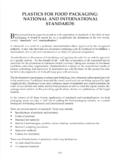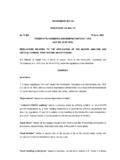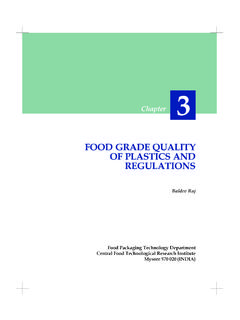Transcription of Protective GLOVES for food contact - SYNAMAP
1 Protective GLOVESfor food contactPersonal Protective Equipment Protective GLOVES COMMISSIONE uropean regulation for materials in food contact1935/2004 European regulation on materials and articles intended to come into contact with foodFramework regulation - for all materials and on material s inertia and safety principles. Additional specific regulations for plastics, recycled plastics, regenerated cellulose, ceramics and active and intelligent materials and articles (positive lists, migrations).States requirements on labelling, declaration of compliance and and safety principlesIt shall not transfer constituents to food that could endanger human shall not bring about an unacceptable change in the composition of the shall not bring any deterioration in the organoleptic characteristics of the and informationThe Protective GLOVES or their packaging shall bear the contact can be expressed in two ways :words such as : for food contact or the symbol It shall also be indicated :- any special instruction for a safe use, for example a limitation for contact with fats;- the name and address of the entity responsible for placing on the market; - a labelling or identification to ensure shall be ensured at all stages in order to facilitate control, the recall of defective products, consumer information and responsibilities.
2 It includes the upstream traceability to the suppliers and downstream to the of compliance (DoC)The concerned GLOVES shall be accompanied by a written declaration stating compliance and appropriate documentation shall be made available to the competent authorities on demand in order to demonstrate compliance (eg. test reports).Regulation 2023/2006 Good Manufacturing Practices (GMP)GMP applies to all materials and articles concerned by the framework regulation 1935/2004 :GMP applies to all materials and articles concerned by the framework regulation 1935/2004:Manufacturing according to an effective and documented quality assurance system,raw materials under specifications, instructions and manufacturing and efficicent quality control system, enabling to quickly take corrective measures in case GMP are not correctly followed, and an appropriate documentation to demonstrate compliance and safety of the 10/2011 PlasticsReguation2023/2006 Good manufacturing practicesRegulation 10/2011 PlasticsApplicable to plastics such as PVC, PE, PP, PU, Polycarbonates, Polyester does not concern rubbers and silicones for wich existing national laws does not concern textile synthetic fibers, the positive list of the regulation may be used The kotex list may also be does not concern stainless steel, the French standard NF A 36-711 - Acier hors emballage - Acier inoxydable destin entrer au contact des denr es.
3 Produits et boissons pour l alimentation de l homme et des animaux , may be list of substances - monomers, manufacturer shall check that all ingredients used are migration limits (hazardous substances)Some substances may have a limit manufacturer shall check that these substances are released within acceptable limits when subjected to a contact with food : vinyl chloride, the PVC monomer, must be checked below 1mg/kg of food substance without specific limit in the list must be checked below 60 migration limit (overall stability)The product must not release substances into the food simulants - limit less or equal to 10 mg/dm (of surface in contact ).The manufacturer shall check that the product does not release any substance above the limit when subjected to a contact with the food simulant concerned by the recommended application (see hereafter).For specific and overall migrationsThe simulants are : Acetic Acid 3% , Ethanol 10%, 20%, 50%, Vegetable to the food intended to come into contact , the regulation lists the simulants to be used (see annex III of the regulation).
4 A dry simulant, poly (2,6-diphenyl-p-phenylene oxide) may also be used for dry contacts the the test with vegetable oil is not feasible, the test is done using ethanol at 95% and isooctane, the worst result must be test using vegetable oil may be considered too severe if compared to the use of certain fat foodstuffs; in such case, a correction factor must be applied (see Annex III of the regulation). If the manufacturer claims that the glove can be used with all foodstuffs, the tests shall be performed using the following simulants: acetic acid 3%, ethanol 10% and vegetable oil. Example 1 : For a glove used exclusively for canned fish in oil: use ethanol 10% and vegetable oilExample 2 : Glove used in contact with bakery products that might have fat surfaces, the result of migration in vegetable oil divided by 3 must be within the limit of 10 mg/dm .Testing conditionsThe worst conditions of use shall be used ( contact time and temperature).
5 In case of repeated contacts, the test shall be done three times on a same test sample with a renewed simulant, the compliance is measured after the third test. The conditions stated in directive 82/711 may be used until January 1, an example, if the GLOVES are used in handling at room temperature with almost permanent contacts, the tests shall be done at 40 C with a 2 hours contact . National lawsNational laws will apply where no specific European regulation exists. For instance, for rubbers and silicones: France : Rubbers : November 9, 1994 lawSilicones : November 25, 1992 law Germany : Rubbers : BfR XXIS ilicones : BfR XV Italy : Ministerial law dated March 21, 1973 Laws may also exist in other countries (Bulgaria, Czech Republic, Spain, the Netherlands etc.).National law RUBBERThey include :- positive lists of authorised ingredients,- specific migration limits,- overall migration manufacturer shall perform the tests to prove compliance If not one directly by the manufacturer, competent bodies in the various countries may perform them*.
6 A glove in compliance in one country may not comply in another country. Ex : polychloroprene (neoprene) is authorised in Germany but not in for overall migrations are more drastic in France than in Germany (2 hours at 40 C against 10 minutes at 40 C in Germany).* Beware : the manufacturer is responsible to declare that the glove is in compliance, and not the testing body; it is thus possible to have the tests deemed useful for the intended use to be performed and not exhaustively all possible tests, which are useless and french national lawFOR RUBBERS - Law dated 9 November 1994 Specific MigrationsSubstancesLimitTotal N-nitrosamines1 g/dm Total N-nitrosables10 g/dm Aromatics amines1mg/kgVOC (Volatile Organic Compounds) mg/kgPeroxydesnegativeOverall migrations Conditions : 2 hours - 40 CLimit (mg/dm )Acetic acid 3%10 Ethanol 10%10 Olive oil10 Ethanol 50%10 Declaration of compliance (example)DECLARATION OF COMPLIANCETO THE REGULATION FOR MATERIALS AND ARTICLESIN food CONTACTThe undersigned < name, function, company>declares that the glove <reference, designation, materials, design>complies to the requirements.
7 < add as relevant>- of the 1935/2004/CE regulation dated 27 October 2004- of the 2023/2006/CE regulation dated 22 December 2006 modified, relative to good manufacturing practices- of the French Law dated 9 November 1994, relative to rubbers in food contactThe glove in reference can be used : < add as relevant> - in contact with all foodstuffs - only o in contact with dry foodstuff o in contact with wet food or water based products o in contact with alcohol based foodstuff o in contact with acid foodstuff o in contact with fat foodstuff < correction factor or type of foodstuff if limited>This declaration of compliance is based on the following data : < add as relevant> - Tests on overall migrations - Test on substances subjected to restrictions (including specific migration) - Declaration of the raw materials suppliersThis declaration is written as required by article 16 of the 1935/2004 regulation and the French law 2007-766 at.
8 , on ..< signature and company stamp> Protective GLOVES for food contactThe GLOVES must comply to the applicable regulation (PPE, food ).The GLOVES must comply with the functional and protection requirements in the workplace :In addition to the usual selection criteria, food contact implies the following :- It must be possible to decontaminate or wash any reusable If a white colour is usually selected as an hygienic feature, a blue colour may more appropriate to detect any glove debris in the handled food . - Avoid powdered GLOVES Even if acceptable for food contact , the powder (usually vegetable starch) may contaminate the foodstuff; it may also contain GMOs. Moreover, powdered natural rubber latex GLOVES may sometimes contain higher levels of allergenic Avoid PVC or vinyl GLOVES which contain phthalates as plasticizers, especially in wet contacts or with fats, even if phthalates are not formally prohibited.
9 - Avoid flocklined GLOVES ; the short fibers may contaminate; inner knitted GLOVES , where the knit is made of continuous yarns are not contaminating. Handling in dry condition, quality control, Horeca : single hand powderfree natural latex or nitrile disposable handling, preparation of poultry, vegetable: liquidproof reusable unlined natural rubber latex GLOVES or nitrile glovesHandling in wet, hot or cold environment : liquidproof GLOVES with cotton or insulating inner liningCutting meat : chainmail glove on the hand at risk (not holding the knife) or high tenacity fibre glove for lower cut risksFor additional information : European regulations : French laws : German BfR : Italian ministerial law : Information on the LNE website : Document listing the regulation in various European countries for rubber in food contact : Rubber products intended to come in contact with foodstuffs version 1 10/06/2004 Public Health Committee of the Council of Europe dit photo : "Elisabeth Deschamps".
10 SYNAMAP Syndicat national des acteurs du march de la pr vention et de la protection39/41 rue Louis Blanc - 92400 COURBEVOIET l. : 01 47 17 64 36 - Fax : 01 47 17 64 97.









